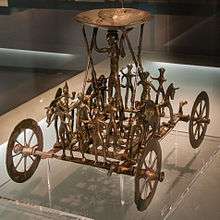Strettweg Cult Wagon


The Cult Wagon of Strettweg, or Strettweg Sacrificial Wagon, or Strettweg Chariot is a bronze cult wagon from ca. 600 BC, which was found as part of a princely grave of the Hallstatt culture in Strettweg near Judenburg, Austria in 1851. Besides the wagon, other grave goods, like jewelry, bronze amphorae, iron weapons, and tack and harness gear were found.
The wagon consists of a square-shaped, open-worked base plate with four spoked wheels. A female figure approx. 32 cm high holding a bowl-shaped object in upraised hands stands in the center of the wagon. The bowl is also held on the sides by two scissor-shaped supports. Recent restoration work and examination by experts has concluded that the bowl attributed to the wagon up to now cannot be conclusively proven to originally have been part of the cult wagon . In addition to the kettle bearer, numerous other figures in the form of both standing and mounted people as well as animals similar to deer and to horses are present on the wagon. The depicted scene is interpreted as a sacrifice. The wagon presumably served as a cult object for the consumption of a libation.
The Strettweg Sacrificial Wagon was restored in 2009 and is on display in the newly redesigned Archaeology Museum of Styrian Universalmuseum Joanneum at Schloss Eggenberg in Graz. A copy is on display in the museum in Judenburg.
Literature
- Markus Egg: Neues zum Fürstengrab von Strettweg. 1991.
- Markus Egg, Gerhard Stawinoga: Das hallstattzeitliche Fürstengrab von Strettweg bei Judenburg in der Obersteiermark. Römisch-Germanisches Zentralmuseum, Forschungsinstitut für Vor- und Frühgeschichte, 1996, ISBN 3-88467-036-0
External links
- The Strettweg Chariot on the Joanneum website with photo
- aeiou Austria Encyclopedia website with photo
Coordinates: 47°04′34″N 15°23′34″E / 47.07614°N 15.39274°E